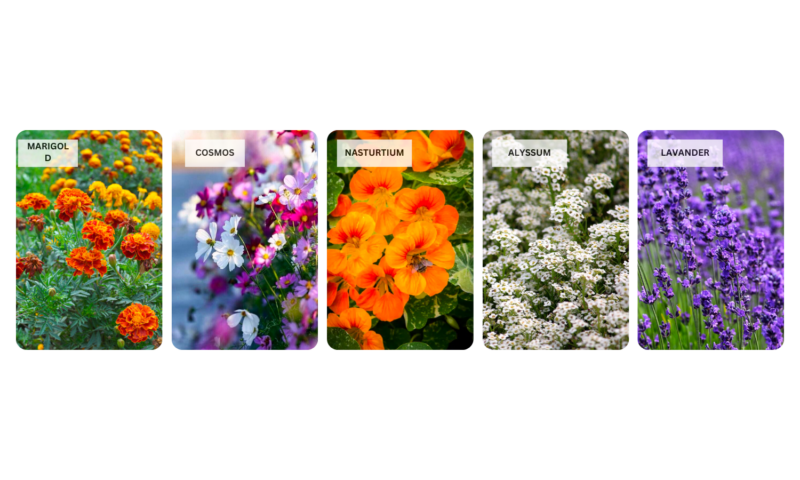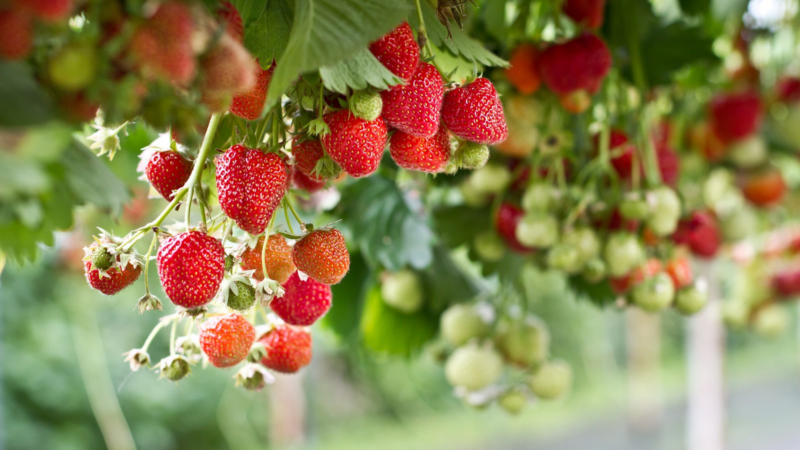Rosemary is a fragrant herb originating in the Mediterranean. It’s a common ingredient in savory dishes, drinks, perfumes, and skin care products for its aroma and health benefits. You can also use it to make rosemary teas, as well as, rosemary aroma oils.
It belongs to the mint family, Lamiaceae, alongside other herbs such as oregano, basil, thyme, and lavender. However, the best way to bring out your rosemary’s potential is to plant it alongside other herbs. Plants have their language and thrive in other plants’ presence.
Companion planting is the best way to make your rosemary thrive and increase its aromatic and medicinal properties.
🔑 Key Takeaways
|
What Are Companion Plants?
Companion planting is a common gardening practice where different types of plants are grouped and planted together. The proximity of these plants aids in improving growth, repelling pests, avoiding diseases, and increasing pollination. This also attributes to symbiotic relationships where both species benefit from closeness.
When planting companions for herbs, vegetables, fruits, and flowers, it’s good to find plants that complement each other. Another basis for choosing companion plants is to group them within the same family or group pest-attracting plants with strong-smelling ones.
| 💡 Did You Know?
Rosemary’s aroma helps deter carrot flies and bean beetles, making it a good companion plant for radish crops. |
There’s no easy way or scientific basis for planting companion plants. A seasoned herbalist or gardener can quickly notice which plants to grow together and which ones to separate. It’s all based on observation and experience.
Companion Plants for Rosemary
When planting herbs, vegetables, flowers, and fruits, partnering them with rosemary is best. Both plants will benefit from the scent and taste of each other, bringing new sights and smells to your garden.
If you are a beginner, here is a compilation of plants known to complement rosemary:
1. Herbs
Rosemary benefits from herbs in many ways. It enhances the flavors and scent of rosemary, creating more savory dishes and new gastronomic experiences.
- Chives: Planting this with rosemary gives off a potent aroma that keeps pests away. They are frequently produced together as rosemary enhances the flavor of chives.
- Sage: When placed alongside rosemary, these two plants help shield their surroundings with an intense aroma that drives off pests, preventing even deer and rabbits from eating vegetation.
| 💡 Did You Know?
Sage also brings nitrogen to the soil and supports the growth of rosemary with essential nutrients and cold weather. |
- Thyme: There are many ways to propagate Thymes, which include propagating alongside rosemary. It belongs in the same family as rosemary, and both provide pest relief from cabbage worms.
These two also offer new flavor profiles and scents, as thyme gives off a zesty lemon flavor while rosemary is more earthy with traces of pine.
- Oregano: This low-lying plant benefits and grows better when planted with rosemary. It thrives in the shade, and tall rosemary bushes provide this. Oregano also balances its soil with pH levels, making both plants healthier.
- Marjoram: Its sweet-smelling and hardy component blends well with rosemary’s warm aroma. Both benefit in companion planting as rosemary drives away pests that are attracted to marjoram, while the latter sweetens the flavor of rosemary. Marjoram also promotes faster growth by releasing compounds into the soil.
2. Vegetables

- Carrots: Cultivating carrots has been a bane to gardeners since carrot flies tend to invade the vegetable. These pests eat the roots and lay eggs on the surrounding soil. Planting odorous rosemary prevents carrot flies and will give your carrots good health and a taste boost.
- Parsnips: Carrot flies are also attracted to parsnips and will significantly benefit when planted with rosemary.
- Onion: Rosemary and onions are great companion plants as both deter garden pests. When grown together, they adapt each others’ flavors, making them a tasty addition to dishes.
- Pepper plants: Rosemary plants keep the soil moist, weed-free and pest free. This can help pepper plants last longer and be more robust. When planted together, both plants improve in taste.
- Brassicas: Cruciferous vegetables are vulnerable to cabbage moths. This includes brassicas. Rosemary acts as a shield to this vegetable, making them safe from pests.
- Beans: Mexican bean beetles are common pests that harm beans. They hate strong scents from rosemary, making it a good companion plant in your vegetable garden. Beans also provide an excellent nitrogen supply in the soil, giving rosemary herbs growth boosts.
3. Flowers

- Marigolds: This bright and vibrant flower is renowned for its pest-repelling properties and can help safeguard rosemary plants against aphids, nematodes, and other pests.
- Cosmos: It blooms annually with varying shades of flowers and are generally pests and disease resistant.
- Nasturtium: Known to keep pests away, nasturtiums will keep your rosemary plants safe from insects and makes a great companion flower.
- Alyssum: These tiny flowers produce sweet-smelling scents that attract bees and other pollinators, making them good companions for propagating rosemary.
- Lavender: Rosemary and lavender belong in the same family, making the two plants complementary. This brings aromatics, and the contrast between purple and bright green will also brighten your garden.
4. Fruit

- Strawberry: The sweet and juicy fruit of strawberry bushes is a favorite among garden pests, birds, and animals. Rosemary’s potent perfume will cover the smell of strawberries, making it safe and secure from harm. Both plants also prefer sunny environments and soil that drains well.
Many other fruits can benefit from rosemary, like raspberries, cherries, apples, and blueberries.
Rosemary is a wonder plant that brings new tastes, aromas and adds beauty to any part of your garden. Whether in your kitchen’s herb pot or vegetable plots, they are versatile plants that need more acknowledgment.
The Benefits of Companion Planting
Overall, companion planting is a helpful gardening method that keeps plants stronger, longer, and away from pests and diseases. This also makes them more capable of numerous supportive roles within your garden’s ecosystem.
These benefits are:
- Bug and Pest Defense – Various pests plague gardens. These target plants within the area. However, they can be deterred when planted alongside rosemary, marigold, and other sweet-smelling or aromatic plants.
- Attracts Pollinators and Beneficial Insects – Fragrant flowers and herbs attract valuable pollinators such as bees and ladybugs to plants. These encourage vegetation to pollinate more effectively.
- Improve Plant Growth and Health – Due to their symbiotic properties, plants can help promote faster growth and enhance the flavor profile of certain vegetables, herbs, and fruits. Making it more palatable and better tasting.
- Provide Ground Covers – Low-lying plants (like oregano, rosemary, and thyme) cover its nearby soil with blanket-like growths, shielding it from the sun and keeping it cooler for plants that require shade or cool climates.
- Acts as Shade – Sun-sensitive plants can benefit from tall and leafy plants, such as asparagus and hollyhocks, providing much-needed shade on plants.
- Adds Beauty to Any Garden – Attractive plants are great companions to other plants in any garden. They bring color and scents and encourage eye-catching plants to blossom.
- Used as Plant Markers – Some plants require longer growing times, making it challenging to determine the rows and places of slow-growing plants. Gardeners use companion planting to guide them on what plant belongs in a plot.
| 👍 Helpful Article:
If you are planning to create a herb garden, check out these amazing herb garden ideas: |
Final Words
You can help your rosemary reach its full potential by planting it alongside other herbs, vegetables, fruits, and flowers. Companion planting is a great way to encourage growth and enhance flavor and aroma.
These plants create a diverse ecosystem by attracting bees and beneficial insects, increasing pollination. So the next time you have rosemary, consider incorporating companion plants to boost your garden’s beauty and power.
FAQs
Can I plant rosemary and basil together?
While rosemary and basil can be planted together, it’s crucial to consider their unique requirements and development patterns.
Does rosemary need full sun?
It is best with full sunlight, at least six hours per day. It has a low tolerance to shade, so transferring it indoors can cause issues.
What helps rosemary grow?
It grows best in sunlight and well-drained soil. It also thrives in a not too-acidic soil. If you have heavy clay soil, putting your rosemary in pots is best.














